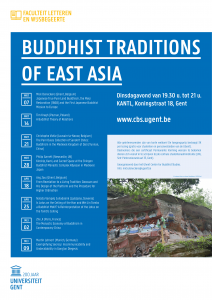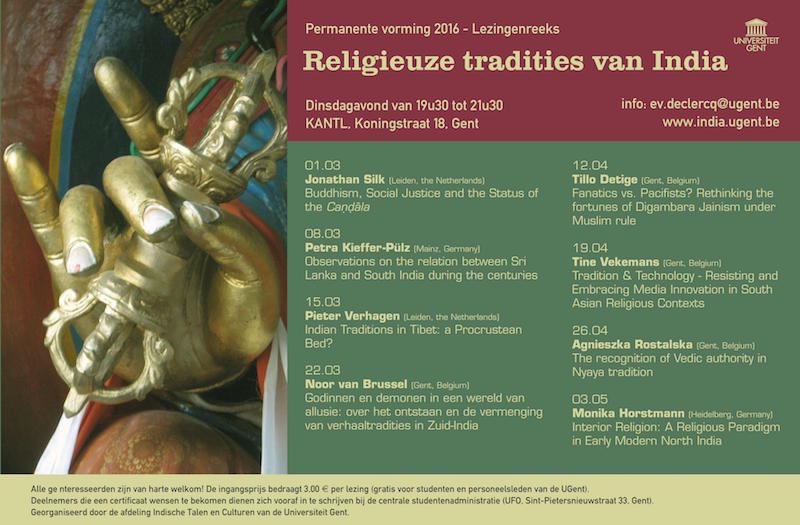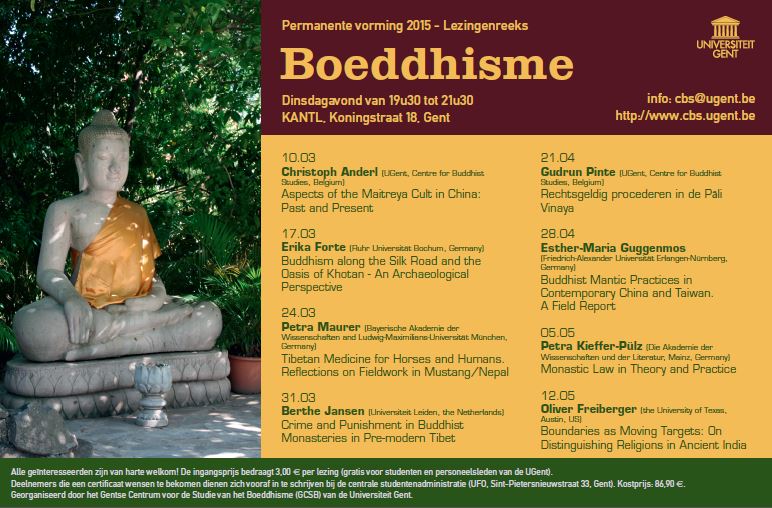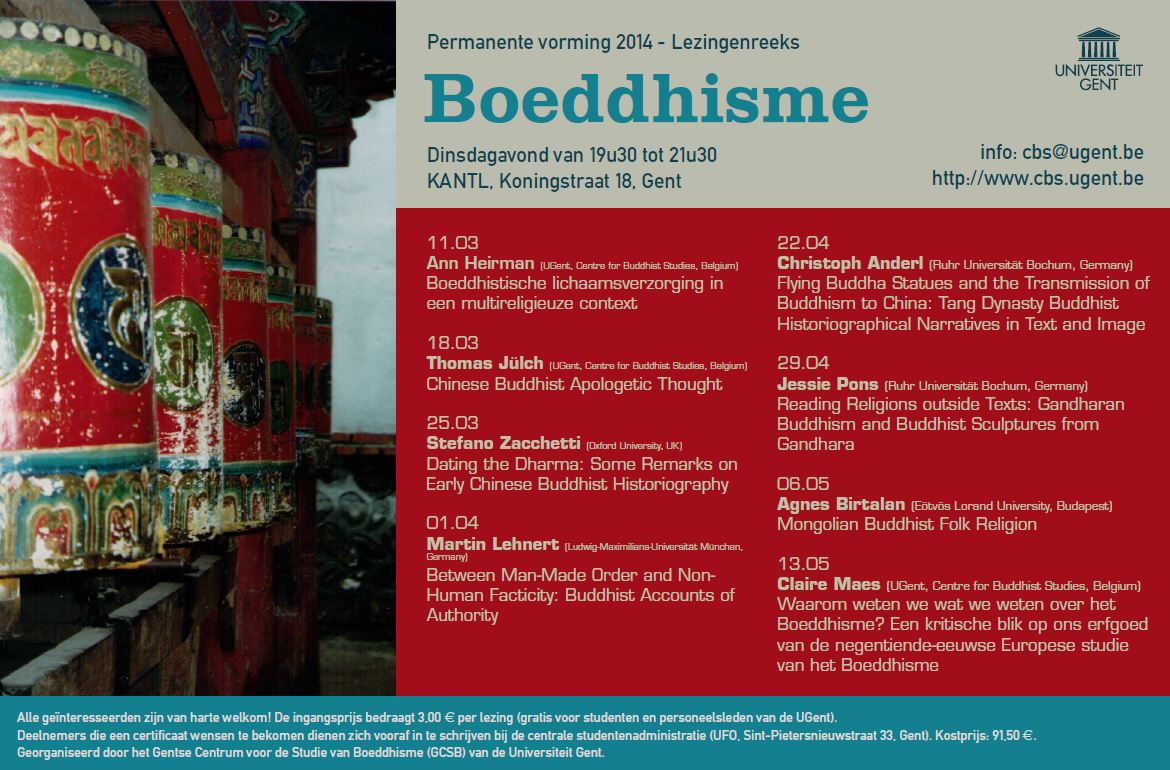Buddhism is a driving force in many regions of the world. Yet many aspects of it remain unknown. This is especially true when it comes to everyday praxis, to people now and in the past who incorporate Buddhism into their daily lives. This is the common thread throughout this lecture series. For anyone interested in religions of the world!
Organized by the Ghent Centre for Buddhist Studies, Permanent Training in Buddhist Studies lecture series – 2025 will take place on Tuesdays, 19:30-21:30 CET, in the Atrium of the Faculty of Arts and Philosophy Library (Rozier 44). Please visit the website of the Humanities Academy to register.
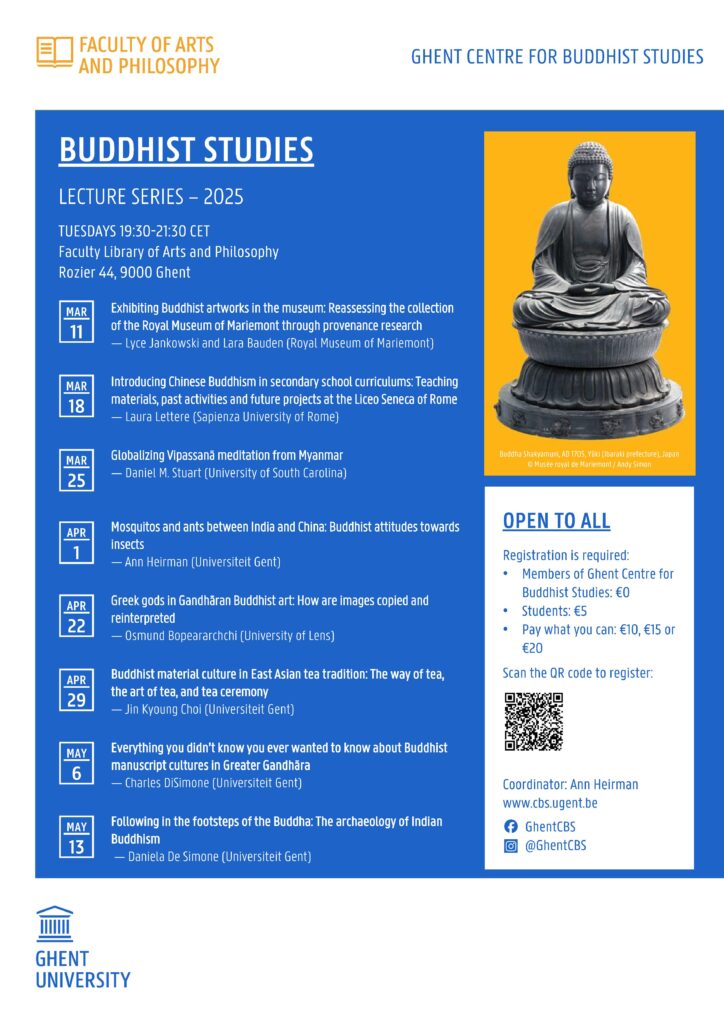
Tickets
- Members of Ghent Centre for Buddhist Studies: €0 (registration is required)
- Students: €5
- Pay what you can: €10, €15 or €20
Program
11 March 2025 – Exhibiting Buddhist Artworks in the Museum: reassessing the collection of the Royal Museum of Mariemont through provenance research
- by Lyce Jankowski and Lara Bauden (Royal Museum of Mariemont)
The Royal Museum of Mariemont houses a significant collection of Buddhist art, acquired by its founder, Raoul Warocqué, in the early 20th century. This collection includes statuary from various regions of Asia, such as Gandhara, Thailand, Vietnam, China, Japan, and Nepal, but, despite its richness, it has been poorly documented. Through provenance research, we have re-evaluated the identification and dating of many of these items, revealing surprising discoveries. The ongoing exhibition Sensing the Buddha showcases a selection from this collection. Although displayed in a secular museum, the exhibition aims to respect the sacred dimensions of the objects.
Tuesday 18 March 2025 – Introducing Chinese Buddhism in Secondary School Curriculums: Teaching Materials, Past Activities and Future Projects at the Liceo Seneca of Rome
- by Laura Lettere (Sapienza University of Rome)
The teaching of Chinese Language and Civilization in Italian high schools has a twenty-year history – as of 2018, around 200 Italian schools included Chinese language instruction in their curriculum. This presentation will briefly outline the structure of the Chinese Language and Civilization curriculum in linguistic high schools in Italy, focusing specifically on the teaching of Chinese culture, and particularly Chinese Buddhism, to students in their third, fourth, and fifth years of high school.
The presentation will address the treatment of Chinese Buddhism in textbooks and the educational activities planned for the third and fourth years, where the subject intersects with cross-cutting topics such as cultural otherness, gender equality, emotional management, and traditional interdisciplinary themes like travel. The analysis of Chinese-language texts provides opportunities for in-depth discussions on narratology and style.
The discussion will explore how a predominantly religious theme can be adapted for multicultural classrooms, including through field trips to visit places of worship within the Chinese community in Rome. The presentation will conclude with the introduction of a planned educational activity for the 2025/26 school year, illustrating how teachers’ specific research interests and fieldwork experiences in China or other Sinophone countries can offer fresh insights and practical tools to meet the educational needs of fifth-year high school students.
Tuesday 25 March 2025 – Globalizing Vipassanā meditation from Myanmar
- by Daniel M. Stuart (University of South Carolina)
In this lectureI extend previous research on the history of mid-twentieth-century Burmese vipassanā (insight) meditation through an exploration of some of the particularities of the meditation-teaching models of the lay meditation master and first Accountant General of Independent Burma, Sayagyi U Ba Khin (1899–1971). While much scholarship has glossed over the charismatic healing modalities of U Ba Khin and his students, I argue here that charismatic healing was at the center of U Ba Khin’s teaching practices. What is more, U Ba Khin’s charismatic approach to meditation and meditation teaching was embedded in a missionary theory that shared thematic elements with esoteric weizzā (wisdom-power) traditions oriented to spiritual practices that might lead to world-domination in a postcolonial Burmese context. Drawing primarily on U Ba Khin’s oral Burmese Dharma talks, I suggest that U Ba Khin’s mission to spread vipassanā in the twentieth century can best be understood as the project of a weizzā-dho (Pāli: vijjādhara), a wizard wielding a particularly powerful form of vipassanā-vijjā (the wisdom-power of insight meditation). I also explore how the post-war context of U Ba Khin’s mission, his concerns around the fallout of the use of nuclear weapons in the Asian theatre, and his attempt to scientize Buddhist theories of matter, influenced how he understood the process of vipassanāmeditation.
Tuesday 1 April 2025 – Mosquitos and Ants Between India and China: Buddhist attitudes Towards Insects
- by Ann Heirman (Ghent Centre for Buddhist Studies)
Buddhist texts generally prohibit the killing of all sentient beings. This is certainly the case in vinaya (disciplinary) texts, which contain strict guidelines on the preservation of all human and animal life. When these vinaya texts were translated into Chinese, they formed the core of Buddhist behavioural codes, influencing both monastic and lay followers. Chinese vinaya masters, such as Daoxuan 道宣 (596–667) and Yijing 義淨 (635–713), wrote extensive commentaries and accounts, introducing Indian concepts into the Chinese environment. In this lecture, we focus on an often neglected aspect of inflicting harm on sentient beings: namely, the injury that may be caused to some of the world’s smallest animals — insects. Some insects produce economically valuable products, such as silk and honey; others, such as mosquitoes and ants are annoying or dangerous; and still others are innocent victims of essential human activities, such as earthworms that are killed when farmland is tilled. Yet, all of these are sentient beings that — according to Buddhist principles — should not be harmed or killed. What this implies for Chinese vinaya masters, and especially the highly influential Daoxuan, is the core question of this lecture. As we will see, their responses are mixed, but they always attempt to remain true to the basic principles of Buddhism.
Tuesday 22 April 2025 – Greek gods in Gandhāran Buddhist art: How are images copied and reinterpreted
- by Osmund Bopeararchchi (University of Lens)
The Gandhāran Budhist art flourished under the auspicious political domination of the Kuṣāṇ Empire in a vast region which was once the cradle of diverse political supremacies and civilisations, such as those of the Achaemenids, the Greeks, the Scythians and the Parthians. The presence of Western powers in the fertile lands of Gandhāra and Greater Gandhāra for many generations gave birth to an innovative art characterized by naturalism and narrative power. The specificity of Gandhāran art is also its ability to narrate an Indian story, namely the life story of the Guatama Buddha, his previous lives and peripheral stories using both Western and Indian artistic motifs. The presence of Greeks in the area since the conquest of Alexander the Great is an important historical fact. This talk highlights how, thanks to these cross-cultural interactions, a new complex art with an iconographic program illustrated by its singularity was born in Gandhāra. The purpose of this presentation is to examine how Greek gods and heroes were used to dramatize the life story of Gautama Buddha.
Tuesday 29 April 2025 – Buddhist Material Culture in East Asian Tea Tradition: The Way of Tea, the Art of Tea, and Tea Ceremony
- by Jin Kyoung Choi (Ghent Centre for Buddhist Studies)
Europeans have been enjoying tea since the Dutch East India Company first introduced it to the continent in 1610. However, the historic development of tea culture as practiced in
East Asia remains relatively underexplored and is often perceived as exotic by the global majority. Despite growing interest, particularly among younger generations in the West, there is a lack of comprehensive academic research and reliable publications to deepen our understanding of the living traditions of “skillfully” brewing and enjoying tea. In this lecture,
We will delve into the history and evolution of one of the most refined tea practices, the Gongfu tea ceremony, which has spread from China across East Asia. We will explore how Buddhism shaped the development of tea culture in China, Taiwan, Japan and Korea, while also examining how tea rituals have been adapted within various Buddhist schools, including Chan (Zen) and Pure Land traditions. Furthermore, the Gongfu tea ceremony will be discussed in relation to other religious, ethnological, and anthropological contexts, shedding light on its socio-political significance and its role in fostering communal harmony.
Tuesday 6 May 2025 – Everything You Didn’t Know You Ever Wanted to Know about Buddhist Manuscript Cultures in Greater Gandhāra
- by Charles DiSimone (Ghent Centre for Buddhist Studies)
Buddhism flourished well into the first millennium of the Common Era throughout the area of Greater Gandhāra, an area encompassing modern day Afghanistan, Pakistan, and Northern India. During this period, a great multitude and variety of Buddhist literature circulated throughout the area. This talk will present a curated view for non-specialists into the nature of textual transmissions that were circulating throughout Greater Gandhāra in the middle of the first millennium by exploring recently discovered manuscript artefacts from the area.
Tuesday 13 May 2025 – Following in the Footsteps of the Buddha: The Archaeology of Indian Buddhism
- by Daniela De Simone (Ghent Centre for Buddhist Studies)
This lecture explores the archaeology of Indian Buddhism through an examination of key sites associated with the life and teachings of Śākyamuni, the historical Buddha. From his birthplace at Lumbini, to the site of his enlightenment at Bodhgaya, his first sermon at Sarnath, and his final passing at Kushinagar, these sacred locations provide invaluable insights into the material cultures and ritual landscapes of early Buddhism. The discussion will focus on archaeological excavations, structural remains, inscriptions, and artistic developments that shaped the Buddhist pilgrimage circuit in South Asia. Additionally, the lecture will explore Emperor Ashoka Maurya’s role as the first Buddhist sovereign and his patronage in the monumentalisation and expansion of these sites.
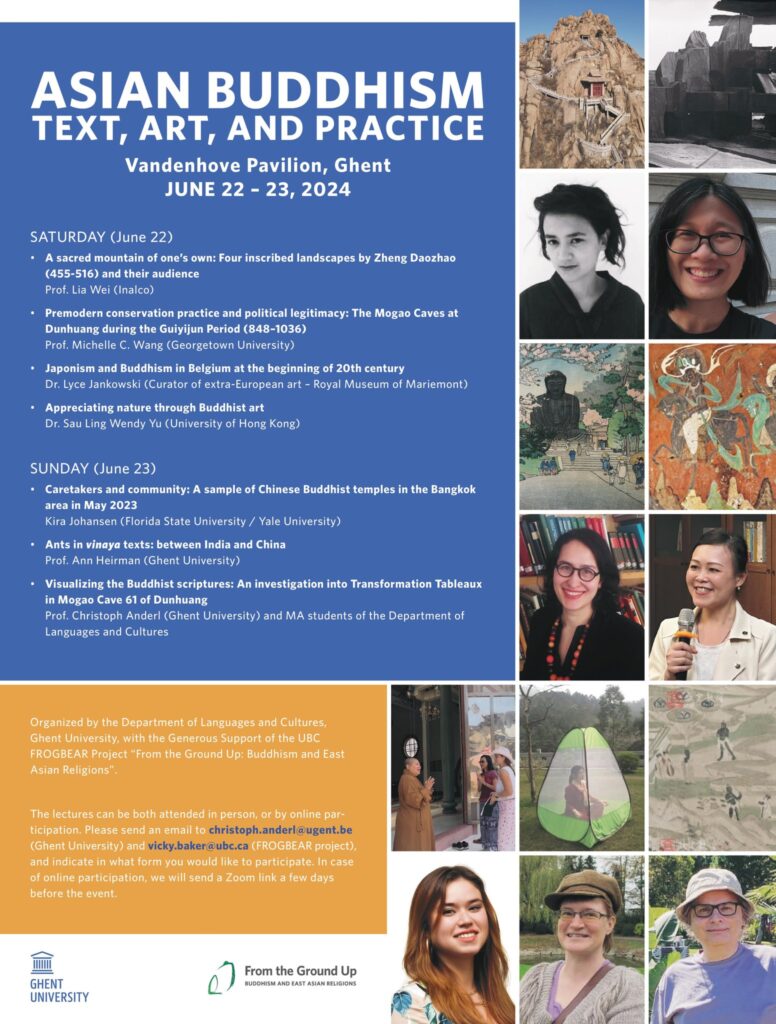
 Lia Wei is associate professor in Chinese art history at the Institut national des langues et civilisations orientales (Inalco). She has been conducting research in China since 2009, with a focus on medieval Buddhist epigraphy and cave temples in Northeast China (Shandong, Hebei, Henan provinces) as well as funerary landscapes in Southwest China (Sichuan, Chongqing, Guizhou, Yunnan, Hubei and Hunan provinces). She received her PhD with a thesis entitled ‘Highland Routes and Frontier Communities at the Fall of the Han Empire (2nd to 3rd century CE): A Comparative Study of Cave Burials South of the Yangzi River’ at the School of Oriental and African Studies (SOAS). In 2018-2021, she was based at the Department of Archaeology and Museum Studies in Renmin University of China. In parallel to her activity as an art historian/archaeologist, she practices seal carving and ink painting, and designs projects that combine academic and artistic research (Ink Art Week in Venice 2018, Lithic Impressions Venice 2018, Ink Brussels 2019, Les cinq couleurs de l’encre 2022, Pratique de l’estampage 2023).
Lia Wei is associate professor in Chinese art history at the Institut national des langues et civilisations orientales (Inalco). She has been conducting research in China since 2009, with a focus on medieval Buddhist epigraphy and cave temples in Northeast China (Shandong, Hebei, Henan provinces) as well as funerary landscapes in Southwest China (Sichuan, Chongqing, Guizhou, Yunnan, Hubei and Hunan provinces). She received her PhD with a thesis entitled ‘Highland Routes and Frontier Communities at the Fall of the Han Empire (2nd to 3rd century CE): A Comparative Study of Cave Burials South of the Yangzi River’ at the School of Oriental and African Studies (SOAS). In 2018-2021, she was based at the Department of Archaeology and Museum Studies in Renmin University of China. In parallel to her activity as an art historian/archaeologist, she practices seal carving and ink painting, and designs projects that combine academic and artistic research (Ink Art Week in Venice 2018, Lithic Impressions Venice 2018, Ink Brussels 2019, Les cinq couleurs de l’encre 2022, Pratique de l’estampage 2023).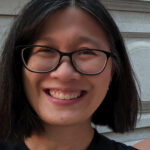 Michelle C. Wang (Department of Art and Art History, Georgetown University) is a specialist in the Buddhist and silk road art of northwestern China, primarily of the 6th-10th centuries. Her first book Maṇḍalas in the Making: The Visual Culture of Esoteric Buddhism at Dunhuang (Brill, 2018) examines Buddhist mandalas of the 8th-10th centuries at the Mogao and Yulin Buddhist cave shrines in northwestern China. She has also written about art and ritual, miracle tales of animated statues, Buddhist materiality, the transcultural reception of Buddhist motifs, and text and image. Her current research examines the reception of medieval silk road sites during the Victorian era.
Michelle C. Wang (Department of Art and Art History, Georgetown University) is a specialist in the Buddhist and silk road art of northwestern China, primarily of the 6th-10th centuries. Her first book Maṇḍalas in the Making: The Visual Culture of Esoteric Buddhism at Dunhuang (Brill, 2018) examines Buddhist mandalas of the 8th-10th centuries at the Mogao and Yulin Buddhist cave shrines in northwestern China. She has also written about art and ritual, miracle tales of animated statues, Buddhist materiality, the transcultural reception of Buddhist motifs, and text and image. Her current research examines the reception of medieval silk road sites during the Victorian era.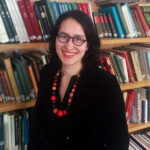 Lyce Jankowski holds a PhD (2012) in Art History from the Paris-Sorbonne University. She is curator of extra-European art at the Royal Museum of Mariemont in Belgium and was previously in charge of the East Asian coin collection at the Ashmolean Museum, Oxford. Her last publication, co-edited with Alice Bianchi, is The Social Lives of Chinese Objects (Brill 2022). Her research interest is on the history of collections and the commodification of East Asian art in Belgium in 19th and 20th century. She is currently researching the provenance of the Buddhist art collection of the Royal Museum of Mariemont.
Lyce Jankowski holds a PhD (2012) in Art History from the Paris-Sorbonne University. She is curator of extra-European art at the Royal Museum of Mariemont in Belgium and was previously in charge of the East Asian coin collection at the Ashmolean Museum, Oxford. Her last publication, co-edited with Alice Bianchi, is The Social Lives of Chinese Objects (Brill 2022). Her research interest is on the history of collections and the commodification of East Asian art in Belgium in 19th and 20th century. She is currently researching the provenance of the Buddhist art collection of the Royal Museum of Mariemont.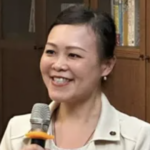 Sau Ling Wendy Yu holds a PhD in Buddhist Art from the Centre of Buddhist Studies at the University of Hong Kong. Her research focuses on exploring the aesthetic aspects of Buddhism as expressed through its art. Wendy believes that the combination of truth and beauty makes Buddhism even more compelling, and she is passionate about promoting this beauty through her research. Wendy is also an avid birdwatcher, bird artist and serves as an EXCO member of the Hong Kong Birdwatching Society. Her passion for birds extends into her research, where she specifically focuses on the bird imagery found in Buddhist art. One notable highlight of her academic journey is her thesis, which was an innovative, cross-disciplinary investigation of Pure Land birds integrating archaeological materials, textual evidence and ornithological knowledge. Birds preach the Dharma in Amitabha’s Pure Land, and Wendy acts as a bridge to share their fascinating stories with the world. Currently, Wendy works as a Research Assistant at the Centre of Buddhist Studies at the University of Hong Kong, where she is responsible for conducting research activities related to Buddhist art. Additionally, she volunteers as a docent at Tsz Shan Monastery Buddhist Art Museum and Hong Kong Palace Museum.
Sau Ling Wendy Yu holds a PhD in Buddhist Art from the Centre of Buddhist Studies at the University of Hong Kong. Her research focuses on exploring the aesthetic aspects of Buddhism as expressed through its art. Wendy believes that the combination of truth and beauty makes Buddhism even more compelling, and she is passionate about promoting this beauty through her research. Wendy is also an avid birdwatcher, bird artist and serves as an EXCO member of the Hong Kong Birdwatching Society. Her passion for birds extends into her research, where she specifically focuses on the bird imagery found in Buddhist art. One notable highlight of her academic journey is her thesis, which was an innovative, cross-disciplinary investigation of Pure Land birds integrating archaeological materials, textual evidence and ornithological knowledge. Birds preach the Dharma in Amitabha’s Pure Land, and Wendy acts as a bridge to share their fascinating stories with the world. Currently, Wendy works as a Research Assistant at the Centre of Buddhist Studies at the University of Hong Kong, where she is responsible for conducting research activities related to Buddhist art. Additionally, she volunteers as a docent at Tsz Shan Monastery Buddhist Art Museum and Hong Kong Palace Museum. Kira Johansen is a recent graduate of Florida State University with a Bachelor’s Degree in International Affairs and a concentration in Religion and French. Following her graduation from Florida State University in August of 2023, Johansen has been accepted and matriculated at Yale University as a Master’s candidate in East Asian Studies starting in the Fall of 2024. Johansen’s primary research focuses on translation and interpretation of the Biographies of Nuns, although she more broadly focused on medieval Chinese Buddhism, and Buddhist nuns. Recently, Johansen has been heavily involved in the University of British Columbia’s From the Ground Up: Buddhist and East Asian Studies (FROGBEAR) Cluster 3.4 Project: “Typologies of Text-Image Relations” as a fieldwork participant and metadata creator for Chinese temples in Bangkok, Thailand. She hopes to incorporate the fruits of this research into a larger research project in the future connecting Chinese diasporas and religiosity to the Thai religious landscape. Along with Christoph Anderl, Johansen is aiding in the compilation of an exhibition on Buddha’s life at the Mariemont Museum (September 2024 – April 2025).
Kira Johansen is a recent graduate of Florida State University with a Bachelor’s Degree in International Affairs and a concentration in Religion and French. Following her graduation from Florida State University in August of 2023, Johansen has been accepted and matriculated at Yale University as a Master’s candidate in East Asian Studies starting in the Fall of 2024. Johansen’s primary research focuses on translation and interpretation of the Biographies of Nuns, although she more broadly focused on medieval Chinese Buddhism, and Buddhist nuns. Recently, Johansen has been heavily involved in the University of British Columbia’s From the Ground Up: Buddhist and East Asian Studies (FROGBEAR) Cluster 3.4 Project: “Typologies of Text-Image Relations” as a fieldwork participant and metadata creator for Chinese temples in Bangkok, Thailand. She hopes to incorporate the fruits of this research into a larger research project in the future connecting Chinese diasporas and religiosity to the Thai religious landscape. Along with Christoph Anderl, Johansen is aiding in the compilation of an exhibition on Buddha’s life at the Mariemont Museum (September 2024 – April 2025). Ann Heirman, Ph.D. (1998) in Oriental Languages and Cultures, is full professor of Chinese Language and Culture and head of the Centre for Buddhist Studies at Ghent University in Belgium. She has published extensively on Chinese Buddhist monasticism and the development of disciplinary rules, including Rules for Nuns according to the Dharmaguptakavinaya (Motilal Banarsidass, 2002), The Spread of Buddhism (Brill, edited volume with Stephan Peter Bumbacher, 2007), A Pure Mind in a Clean Body (with Mathieu Torck, Academia Press, 2012), and Buddhist Encounters and Identities Across East Asia (Brill, edited volume with Carmen Meinert and Christoph Anderl, 2018).
Ann Heirman, Ph.D. (1998) in Oriental Languages and Cultures, is full professor of Chinese Language and Culture and head of the Centre for Buddhist Studies at Ghent University in Belgium. She has published extensively on Chinese Buddhist monasticism and the development of disciplinary rules, including Rules for Nuns according to the Dharmaguptakavinaya (Motilal Banarsidass, 2002), The Spread of Buddhism (Brill, edited volume with Stephan Peter Bumbacher, 2007), A Pure Mind in a Clean Body (with Mathieu Torck, Academia Press, 2012), and Buddhist Encounters and Identities Across East Asia (Brill, edited volume with Carmen Meinert and Christoph Anderl, 2018).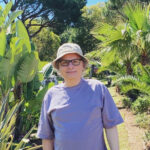 Christoph Anderl specializes on medieval Chinese manuscript culture, Buddhist Chinese, and various topics related to the development and adaptation of Chinese Buddhism during the Tang and Five Dynasties periods. During the last years, his focus has been on the study of modes of representation of Buddhist narratives in textual and visual media, including methodological and theoretical issues concerning the interrelation of text and image. In this context, he has also acted as leader of the
Christoph Anderl specializes on medieval Chinese manuscript culture, Buddhist Chinese, and various topics related to the development and adaptation of Chinese Buddhism during the Tang and Five Dynasties periods. During the last years, his focus has been on the study of modes of representation of Buddhist narratives in textual and visual media, including methodological and theoretical issues concerning the interrelation of text and image. In this context, he has also acted as leader of the 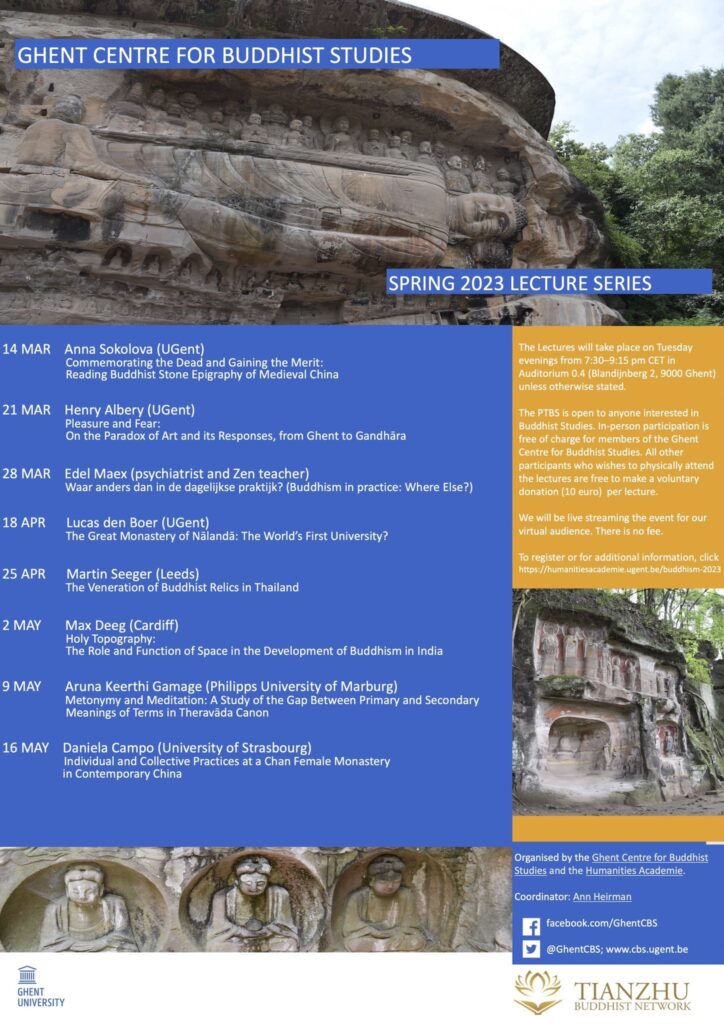
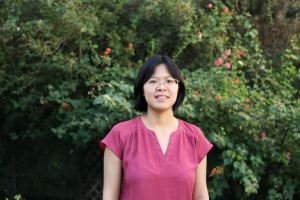 This talk focuses on the historical transformation of Mt. Jiuhua from a local mountain to a national pilgrimage destination and the ways in which Mt. Jiuhua became the divine abode of Dizang Bodhisattva (Skt. Kṣitigarbha), a savior of the underworld beings in Chinese Buddhism, in the late imperial period (14th–20th centuries). This study explains the making of the sacred mountain by analyzing four salient features of local Jiuhua Buddhism. First, it deals with the cult of mummified bodies by looking into local mortuary practices. Jiuhua Buddhists, choosing not to follow the monastic rules concerning cremation, opted to create a successful tradition of mummy-making for the deceased Buddhists. The continuing emergence of new mummies shaped the perceived sacred atmosphere of Mt. Jiuhua. Second, by analyzing relevant precious scrolls (baojuan), it reveals how vernacular literature functioned as a medium for the localization of Dizang. The performance based on such literature that was carried out at Buddhist events was the key to the further dissemination of the image of Mt. Jiuhua as a sacred mountain. Third, it explores the devotionalpractices of the eminent Buddhist master Ouyi Zhixu (1599–1655) on Mt. Jiuhua during his sojourn, and how the highly charged religious atmosphere of Mt. Jiuhua facilitates Zhixu’s devotion to Dizang. Fourth, it argues that the sacredness of the mountain was constructed and negotiated through pilgrimage practices, evidenced by many material objects used in pilgrimage. In summary, in explicating the uniqueness of Jiuhua Buddhism, this study adopts an interdisciplinary approach that bridges religion and geography and contributes to the study of sacred space in Chinese religion. By challenging the artificial dichotomy between “institutional” and “popular” religion and using understudied local materials, this study provides a different evaluation of the vitality of Ming-Qing Buddhism by focusing on religious practices.
This talk focuses on the historical transformation of Mt. Jiuhua from a local mountain to a national pilgrimage destination and the ways in which Mt. Jiuhua became the divine abode of Dizang Bodhisattva (Skt. Kṣitigarbha), a savior of the underworld beings in Chinese Buddhism, in the late imperial period (14th–20th centuries). This study explains the making of the sacred mountain by analyzing four salient features of local Jiuhua Buddhism. First, it deals with the cult of mummified bodies by looking into local mortuary practices. Jiuhua Buddhists, choosing not to follow the monastic rules concerning cremation, opted to create a successful tradition of mummy-making for the deceased Buddhists. The continuing emergence of new mummies shaped the perceived sacred atmosphere of Mt. Jiuhua. Second, by analyzing relevant precious scrolls (baojuan), it reveals how vernacular literature functioned as a medium for the localization of Dizang. The performance based on such literature that was carried out at Buddhist events was the key to the further dissemination of the image of Mt. Jiuhua as a sacred mountain. Third, it explores the devotionalpractices of the eminent Buddhist master Ouyi Zhixu (1599–1655) on Mt. Jiuhua during his sojourn, and how the highly charged religious atmosphere of Mt. Jiuhua facilitates Zhixu’s devotion to Dizang. Fourth, it argues that the sacredness of the mountain was constructed and negotiated through pilgrimage practices, evidenced by many material objects used in pilgrimage. In summary, in explicating the uniqueness of Jiuhua Buddhism, this study adopts an interdisciplinary approach that bridges religion and geography and contributes to the study of sacred space in Chinese religion. By challenging the artificial dichotomy between “institutional” and “popular” religion and using understudied local materials, this study provides a different evaluation of the vitality of Ming-Qing Buddhism by focusing on religious practices.
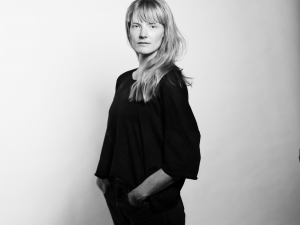 Few icons of Japanese culture are more widely recognized than the sumo wrestler. He sports a loin cloth and a slicked back topknot. His hulking body is aimed to engage. And the sumo wrestler is always a man, in the popular imagination at least. The Japan Sumo Association, a quasi-governmental corporation, champions itself as the custodian of a divine affair cultivated by male deities and mortal men, and exclusive of women. Juxtaposing modern and contemporary sumo literature with historical documents and present-day practices, Dr. DeWitt Prat will peer behind the icon to show how the fantasies surrounding sumo obscure the richness and diversity of its cultural history, a history that includes women.
Few icons of Japanese culture are more widely recognized than the sumo wrestler. He sports a loin cloth and a slicked back topknot. His hulking body is aimed to engage. And the sumo wrestler is always a man, in the popular imagination at least. The Japan Sumo Association, a quasi-governmental corporation, champions itself as the custodian of a divine affair cultivated by male deities and mortal men, and exclusive of women. Juxtaposing modern and contemporary sumo literature with historical documents and present-day practices, Dr. DeWitt Prat will peer behind the icon to show how the fantasies surrounding sumo obscure the richness and diversity of its cultural history, a history that includes women.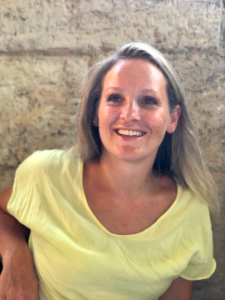 While, within Buddhist Studies, there has been considerable disagreement on the relationship between Buddhism and law, it has been a vastly understudied subject that has fortunately received more academic attention in the past decade. Scholars in the past have equated Buddhist ethics or philosophy with Buddhism tout court. TW Rhys Davids, for example, once remarked that “in the strict sense of the word there is no Buddhist law; there is only an influence exercised by Buddhist ethics on changes that have taken place in customs” (1914: 827). On the other extreme, Rebecca French has positioned for the case of Tibet that “[m]ind training and inner morality are also at the center of the legal system for Tibetan Buddhists” (French 1998: 519) and that “[a]ll laws were understood as religious” (1995: 345). Contemporary scholars of Buddhism and law such as Lammerts and Schonthal attempt to find middle ground, in which Buddhist practice (ie, what Buddhists do), as evidenced either by texts or human conduct, takes center stage. In this talk, I will present a view from early modern Tibet on the complex question of how Buddhism and law intertwine. Using examples from prescriptive legal texts and descriptive legal cases, I will demonstrate in this talk how this entwinement was thought of by Tibetan Buddhists and how this played out in society.
While, within Buddhist Studies, there has been considerable disagreement on the relationship between Buddhism and law, it has been a vastly understudied subject that has fortunately received more academic attention in the past decade. Scholars in the past have equated Buddhist ethics or philosophy with Buddhism tout court. TW Rhys Davids, for example, once remarked that “in the strict sense of the word there is no Buddhist law; there is only an influence exercised by Buddhist ethics on changes that have taken place in customs” (1914: 827). On the other extreme, Rebecca French has positioned for the case of Tibet that “[m]ind training and inner morality are also at the center of the legal system for Tibetan Buddhists” (French 1998: 519) and that “[a]ll laws were understood as religious” (1995: 345). Contemporary scholars of Buddhism and law such as Lammerts and Schonthal attempt to find middle ground, in which Buddhist practice (ie, what Buddhists do), as evidenced either by texts or human conduct, takes center stage. In this talk, I will present a view from early modern Tibet on the complex question of how Buddhism and law intertwine. Using examples from prescriptive legal texts and descriptive legal cases, I will demonstrate in this talk how this entwinement was thought of by Tibetan Buddhists and how this played out in society.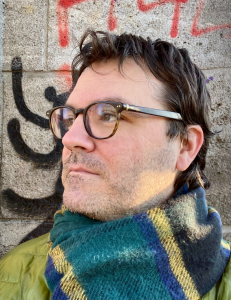 In the modern world we live in one is presented with a seemingly incalculable number of books to choose from, each and every one a perfect product of precise publication parameters printed on pristine pages. For scholars it is as simple as plucking a well-edited tome off a library shelf or, even easier, pressing one’s finger over a ‘download’ virtual button to have primary source material in its original language or even a well-thought (and sometimes not so well thought) translation. These beautiful editions and translations and the studies that result from them are the products of the gritty work of scholars puzzling over various manuscript materials. This talk is designed as a sort of ‘how it’s made’ instruction and will outline the process of the philological and textual study of Buddhist manuscripts from broken artefacts in the ground to critical editions. Recent manuscript discoveries in Greater Gandhāra will serve as focus point around which the talk will revolve.
In the modern world we live in one is presented with a seemingly incalculable number of books to choose from, each and every one a perfect product of precise publication parameters printed on pristine pages. For scholars it is as simple as plucking a well-edited tome off a library shelf or, even easier, pressing one’s finger over a ‘download’ virtual button to have primary source material in its original language or even a well-thought (and sometimes not so well thought) translation. These beautiful editions and translations and the studies that result from them are the products of the gritty work of scholars puzzling over various manuscript materials. This talk is designed as a sort of ‘how it’s made’ instruction and will outline the process of the philological and textual study of Buddhist manuscripts from broken artefacts in the ground to critical editions. Recent manuscript discoveries in Greater Gandhāra will serve as focus point around which the talk will revolve.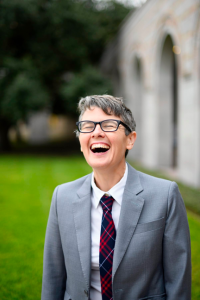
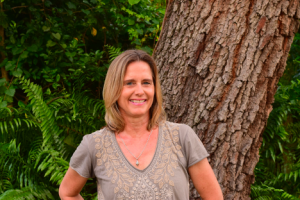 Since the 1980s, North American Buddhist communities have been the site of recurring sexual misconduct and abuse allegations. While efforts to bring about justice have been hampered by denial and deflection from teachers, community leaders, and board members, a number of grassroot initiatives have responded more effectively to abuse. Drawing on ethnographic research in multiple North American and transnational Buddhist communities, we identify an emerging Buddhist sexual ethics in these grassroots justice efforts. We will focus, in particular, on three significant responses to abuse: transparency and accountability, sexual consent, and a survivor-centered orientation. We will map each onto classical Buddhist sexual ethics, illuminating areas of disjunction and overlap. Taking our cue from survivor-center advocacy, we argue that, although a Buddhist sexual ethics is locatable in textual traditions or lineage-based teachings, only critical constructive approaches make classical Buddhist sexual ethics useful for just responses to abuse.
Since the 1980s, North American Buddhist communities have been the site of recurring sexual misconduct and abuse allegations. While efforts to bring about justice have been hampered by denial and deflection from teachers, community leaders, and board members, a number of grassroot initiatives have responded more effectively to abuse. Drawing on ethnographic research in multiple North American and transnational Buddhist communities, we identify an emerging Buddhist sexual ethics in these grassroots justice efforts. We will focus, in particular, on three significant responses to abuse: transparency and accountability, sexual consent, and a survivor-centered orientation. We will map each onto classical Buddhist sexual ethics, illuminating areas of disjunction and overlap. Taking our cue from survivor-center advocacy, we argue that, although a Buddhist sexual ethics is locatable in textual traditions or lineage-based teachings, only critical constructive approaches make classical Buddhist sexual ethics useful for just responses to abuse.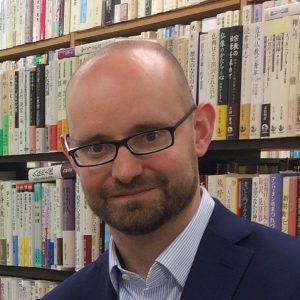
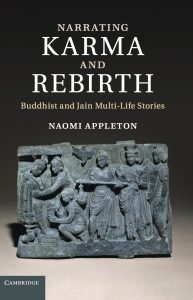 In the famous Lotus Sūtra parable of the burning house, the father promises his three sons three types of vehicle with which they can play, in order to get them to leave the building. When they get outside, their gifts are identical. As any student of Buddhism knows, the three vehicles represent the three ways to reach liberation in early Buddhism: the bodhisattva path leading to full and perfect buddhahood; the path of the śrāvaka or “hearer”, leading to arhatship; and the vehicle that leads to becoming a pratyekabuddha, an independent or solitary buddha. The one vehicle is, of course, the Mahāyāna or “Great Vehicle”. This parable paints a simple picture of the three vehicles of mainstream Buddhism being supplanted by the all-encompassing Mahāyāna, and this has been much repeated in scholarly literature. This paper, which emerges from a collaborative project funded by the UK Arts and Humanities Research Council, offers a more complicated assessment of early Buddhist accounts of paths, vehicles and buddhas, with a focus on Indian narrative literature on both sides of the Mahāyāna divide. Was the idea of three paths or vehicles really taken for granted in non-Mahāyāna contexts? And how do Mahāyāna sources make sense of these categories of liberation as they seek to offer new perspectives? By exploring a range of narrative literature that engages these debates, we shed new light on ideas about buddhahood, and on the role of these ideas in the distinction between Mahāyāna and non-Mahāyāna thought.
In the famous Lotus Sūtra parable of the burning house, the father promises his three sons three types of vehicle with which they can play, in order to get them to leave the building. When they get outside, their gifts are identical. As any student of Buddhism knows, the three vehicles represent the three ways to reach liberation in early Buddhism: the bodhisattva path leading to full and perfect buddhahood; the path of the śrāvaka or “hearer”, leading to arhatship; and the vehicle that leads to becoming a pratyekabuddha, an independent or solitary buddha. The one vehicle is, of course, the Mahāyāna or “Great Vehicle”. This parable paints a simple picture of the three vehicles of mainstream Buddhism being supplanted by the all-encompassing Mahāyāna, and this has been much repeated in scholarly literature. This paper, which emerges from a collaborative project funded by the UK Arts and Humanities Research Council, offers a more complicated assessment of early Buddhist accounts of paths, vehicles and buddhas, with a focus on Indian narrative literature on both sides of the Mahāyāna divide. Was the idea of three paths or vehicles really taken for granted in non-Mahāyāna contexts? And how do Mahāyāna sources make sense of these categories of liberation as they seek to offer new perspectives? By exploring a range of narrative literature that engages these debates, we shed new light on ideas about buddhahood, and on the role of these ideas in the distinction between Mahāyāna and non-Mahāyāna thought.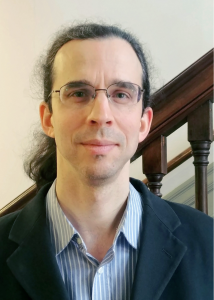 In the grand narratives of the transmission of Buddhism to China, only beginning in the early fifth century did Indian Buddhist literature come to be translated into Chinese in a manner both accurate and comprehensible. Though “accurate” is arguably a normative assessment that we might question, there can be no doubt that many pre-fifth-century Chinese translations of Indian Buddhist texts are very difficult to understand and that later Chinese Buddhists on the whole rarely read, studied, or commented on them. As scholars have in recent years analyzed in more detail the texts attributed to key early translators such as Dharmarakṣa 竺法護, Zhi Qian 支謙, and An Shigao 安世高, we have learned much more about the how these early translations worked. Yet while it is now often possible for us, armed with our knowledge of parallel Indic texts, to see how these early translations were intended to work, it is much harder to know how or whether Chinese readers would have made sense of them. In this paper, I will examine whether early Chinese Buddhists were able to understand their scriptures by looking at the very few cases where we have access to (1) a difficult-understand early Chinese translation, (2) a parallel Indic text that allows us to be nearly certain how the translation was intended to work, and (3) an early Chinese commentary that allows us to see how the passages were understood. Such commentaries once existed for a fair number of pre-Kumārajīva Chinese Buddhist scriptures, though only a few survive within the Chinese Buddhist canon. In recent years, a number of new (albeit fragmentary) commentaries to pre-fifth-century translations have come to light from the Dunhuang and Turfan manuscripts. Drawing from these examples, in this talk I will discuss some cases where early Chinese commentaries evidently preserved accurate knowledge of the original Indian texts that had not been included in the translations proper or which had in the translations been rendered in an impossible to understand form. Here, in short, we have evidence for a living interpretive community, presumably one originating in the original translation event itself, that at least sometimes provided a scaffolding that would have made even impossible-to-understand Chinese translations comprehensible.
In the grand narratives of the transmission of Buddhism to China, only beginning in the early fifth century did Indian Buddhist literature come to be translated into Chinese in a manner both accurate and comprehensible. Though “accurate” is arguably a normative assessment that we might question, there can be no doubt that many pre-fifth-century Chinese translations of Indian Buddhist texts are very difficult to understand and that later Chinese Buddhists on the whole rarely read, studied, or commented on them. As scholars have in recent years analyzed in more detail the texts attributed to key early translators such as Dharmarakṣa 竺法護, Zhi Qian 支謙, and An Shigao 安世高, we have learned much more about the how these early translations worked. Yet while it is now often possible for us, armed with our knowledge of parallel Indic texts, to see how these early translations were intended to work, it is much harder to know how or whether Chinese readers would have made sense of them. In this paper, I will examine whether early Chinese Buddhists were able to understand their scriptures by looking at the very few cases where we have access to (1) a difficult-understand early Chinese translation, (2) a parallel Indic text that allows us to be nearly certain how the translation was intended to work, and (3) an early Chinese commentary that allows us to see how the passages were understood. Such commentaries once existed for a fair number of pre-Kumārajīva Chinese Buddhist scriptures, though only a few survive within the Chinese Buddhist canon. In recent years, a number of new (albeit fragmentary) commentaries to pre-fifth-century translations have come to light from the Dunhuang and Turfan manuscripts. Drawing from these examples, in this talk I will discuss some cases where early Chinese commentaries evidently preserved accurate knowledge of the original Indian texts that had not been included in the translations proper or which had in the translations been rendered in an impossible to understand form. Here, in short, we have evidence for a living interpretive community, presumably one originating in the original translation event itself, that at least sometimes provided a scaffolding that would have made even impossible-to-understand Chinese translations comprehensible.